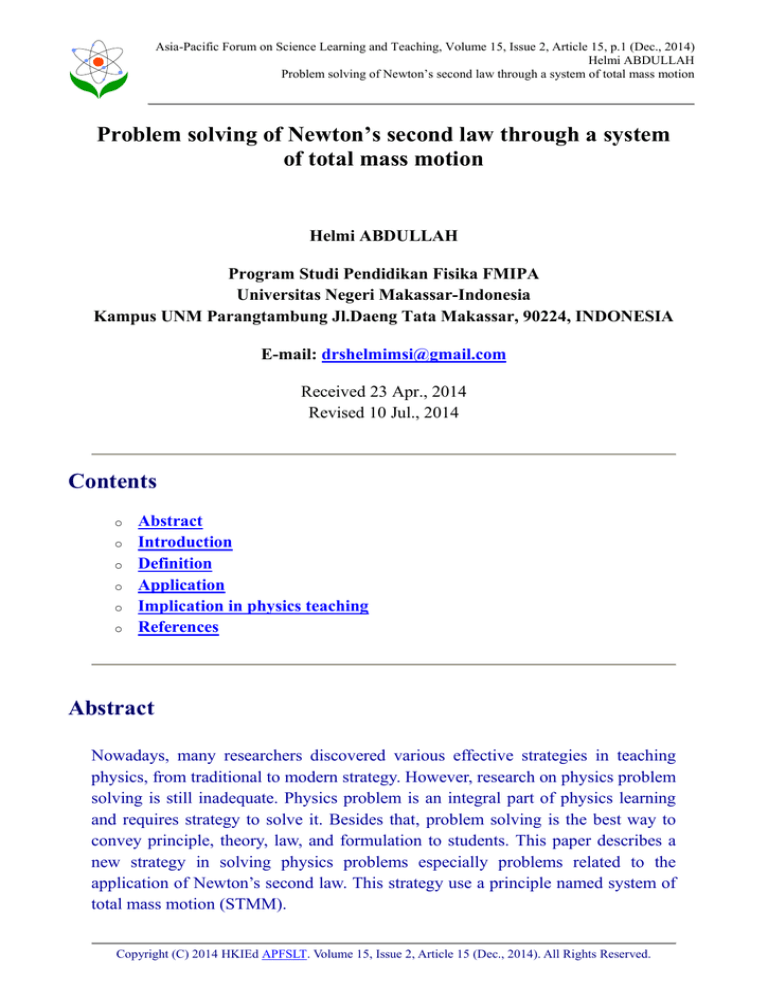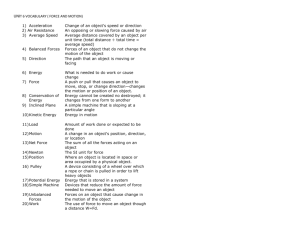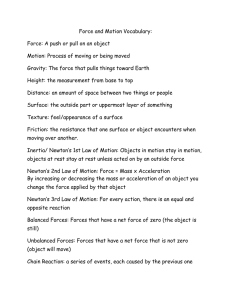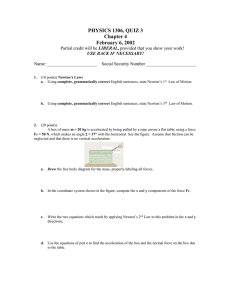
Asia-Pacific Forum on Science Learning and Teaching, Volume 15, Issue 2, Article 15, p.1 (Dec., 2014)
Helmi ABDULLAH
Problem solving of Newton’s second law through a system of total mass motion
Problem solving of Newton’s second law through a system
of total mass motion
Helmi ABDULLAH
Program Studi Pendidikan Fisika FMIPA
Universitas Negeri Makassar-Indonesia
Kampus UNM Parangtambung Jl.Daeng Tata Makassar, 90224, INDONESIA
E-mail: drshelmimsi@gmail.com
Received 23 Apr., 2014
Revised 10 Jul., 2014
Contents
o
o
o
o
o
o
Abstract
Introduction
Definition
Application
Implication in physics teaching
References
Abstract
Nowadays, many researchers discovered various effective strategies in teaching
physics, from traditional to modern strategy. However, research on physics problem
solving is still inadequate. Physics problem is an integral part of physics learning
and requires strategy to solve it. Besides that, problem solving is the best way to
convey principle, theory, law, and formulation to students. This paper describes a
new strategy in solving physics problems especially problems related to the
application of Newton’s second law. This strategy use a principle named system of
total mass motion (STMM).
Copyright (C) 2014 HKIEd APFSLT. Volume 15, Issue 2, Article 15 (Dec., 2014). All Rights Reserved.
Asia-Pacific Forum on Science Learning and Teaching, Volume 15, Issue 2, Article 15, p.2 (Dec., 2014)
Helmi ABDULLAH
Problem solving of Newton’s second law through a system of total mass motion
Keywords: problem solving, Newton’s second law, system of total mass motion
Introduction
Problem solving is an important element as well as an integral part of physics. The
core of physics matter is logic. Principle and theory in physics describe in logical
mathematics in the form of formulation. As an example, Newton second law is
expressed as follows:
a=(∑F)/m
(1)
This equation describes the relationship between acceleration (a) with force (F),
while mass (m) is the object in which both quantities are applied. Force is a cause
factor and acceleration is the effect, so that an object will be accelerated when a
force act upon it. This indicates that equation (1) describes logical thinking about
the movement of an object. Based on this view, physics problem is built on the
basis of logical thinking. As a consequence, problem solving requires a certain
procedure.
In teaching physics, problem solving is an important part of teaching strategy
(Ibrahim and Rebello, 2013). This is because problem solving helps students to
comprehend concepts, principles, laws and formulations. Problem solving is a tool
to train thinking process. Therefore, many researchers recommend problem solving
strategy to be applied in teaching physics (Hull, Kuo, Gupta, and Elby, 2013).
A number of physics university text books such as Serwey & Jewett (2004), Kerr &
Ruth (2008), Bauer & Westfall (2011) describe problem solving procedures. The
most popular one is by using “Free body diagrams (FBD)”. FBD is used
particularly to solve problems related to Newton’s second law. The strategy used is
to use free diagram (Savinainem, Mȁkynem, Nieminem, and Viiri, 2013) As an
example a movement of an object on the surface of a table and pull by another
object (Figure 1 and 2),
Copyright (C) 2014 HKIEd APFSLT. Volume 15, Issue 2, Article 15 (Dec., 2014). All Rights Reserved.
Asia-Pacific Forum on Science Learning and Teaching, Volume 15, Issue 2, Article 15, p.3 (Dec., 2014)
Helmi ABDULLAH
Problem solving of Newton’s second law through a system of total mass motion
Figure 1.
Figure 2.
Figure 3. FBD problem for Fig-1
If the mass of the string and the pulley as well as the friction is neglected, the
acceleration of the system can be determined by using the following procedure: (1)
drawing force components (2) separating motion system for each object or creating,
(3) using Newton’s second law to formulate each object, and (4) executing by using
Copyright (C) 2014 HKIEd APFSLT. Volume 15, Issue 2, Article 15 (Dec., 2014). All Rights Reserved.
Asia-Pacific Forum on Science Learning and Teaching, Volume 15, Issue 2, Article 15, p.4 (Dec., 2014)
Helmi ABDULLAH
Problem solving of Newton’s second law through a system of total mass motion
mathematical operation. For a problem in Fig-1, the solution stages is pictured in
Fig-3.
Stage 4 is executing equations in Fig-3 by substituting both expressions to find the
acceleration. The result is,
a=Mg/(M+m1)
For a problem in Fig-2, the solution procedure is similar to problem in Fig-1,
except that there is m2 behind m1. The solution of stage 1 is shown in Fig-4. The
result of this stage is:
a=Mg/(M+m1+m2)
From both problems, it appears that if the system consists of two objects, the
number of equation is 2, and 3 equations for 3 objects. Hence, if the system
consists of n objects, the number of equation is also n. If this strategy is used, the
main difficulties are the number of equation increase with the number of object. In
order to overcome this problem, we propose a strategy to solve Newton’s law by
using “System of Total Mass”.
Figure 4. FBD for problem fig-2
Definition
Copyright (C) 2014 HKIEd APFSLT. Volume 15, Issue 2, Article 15 (Dec., 2014). All Rights Reserved.
Asia-Pacific Forum on Science Learning and Teaching, Volume 15, Issue 2, Article 15, p.5 (Dec., 2014)
Helmi ABDULLAH
Problem solving of Newton’s second law through a system of total mass motion
System of total mass motion is a strategy to solve Newton’s second law by
considering the motion of object as a system. The procedure follows equation (1),
in the form of,
a=(∑F)/ms =(∑motion force-∑resistive force)/ms
(2)
In this system, ∑F is divided into two components namely motion force and
resistive force. Motion force is the sum of all forces to move the system, resistive
force is the sum of all forces to slow the movement of the system. Fig-5 is an
example for this case.
Figure 5. An example of motion and resistive force
Because Mg>f or M>m and the mass of pulley and string are neglected, M will
move downward. The component force for the object and pulley is Mg and the
component for resistive is f. For the hanging pulley, the component force is Mg and
its resistive force is mg. Hence, the acceleration of the object for both systems is as
follows. For the object:
a=(∑Fmotion - ∑Fresistive)/ms =(Mg-f)/(M+m)
For the pulley system:
a=(∑Fmotion - ∑Fresistive)/ms =(Mg-mg)/(M+m)=(M-m)g/(M+m)
Solution strategy for “system of total mass movement” consist only two stage
procedures, namely: (1) drawing force components or drawing FBD and (2)
Copyright (C) 2014 HKIEd APFSLT. Volume 15, Issue 2, Article 15 (Dec., 2014). All Rights Reserved.
Asia-Pacific Forum on Science Learning and Teaching, Volume 15, Issue 2, Article 15, p.6 (Dec., 2014)
Helmi ABDULLAH
Problem solving of Newton’s second law through a system of total mass motion
applying the formula. The other advantage of this strategy is does not require
rigorous formulation. The formulation (2) can be used directly. Besides that, this
strategy is able to solve a problem contain many objects (Fig-6).
Substituting the above equations, the acceleration of a series of objects can be
written as,
a=(F-(f1+f2+f3+f4+f5))/(m1+m2+m3+m4+m5)
(3)
If the principle of system of total mass is used, the next stage after drawing FBD is
finding the force components to determine the motion and the resistive force:
Figure 6. System of a series of objects
∑Fmotion=F
∑Fresistive= f1+f2+f3+f4+f5
and
ms=m1+m2+m3+m4+m5
Copyright (C) 2014 HKIEd APFSLT. Volume 15, Issue 2, Article 15 (Dec., 2014). All Rights Reserved.
Asia-Pacific Forum on Science Learning and Teaching, Volume 15, Issue 2, Article 15, p.7 (Dec., 2014)
Helmi ABDULLAH
Problem solving of Newton’s second law through a system of total mass motion
The acceleration of the system,
a=(∑Fmotion-∑Fresistive)/ms=(F-(f1+f2+f3+f4+f5))/(m1+m2+m3+m4+m5)
(4)
This equation is similar with equation (3).
Application
Strategy of total mass can also be applied to various problems where the mass of
pulley is not neglected. The mass of the pulley (m) is written as mi. This term is
used to find the total mass. As an example, the moment of inertia of the pulley is
given by I=1/2 mR2, in general can be written as:
I=1/2 mR2=cmR2=miR2
Here for the pulley mass the value of c =1/2 (constant), and mi = 1/2 m=cm. By this
definition the total mass motion can be determined easily. In order to know the
application of the total mass strategy, the problem in a plane, a hanging pulley and
an elevated plane will be considered.
(a) Problem on a plane and a hanging pulley
Figure 7. System of an object and a pulley
The mass of string is neglected, but the mass of the pulley is included. By using the
strategy of total mass motion, the system of the object on the table can be
determined as follows,
Copyright (C) 2014 HKIEd APFSLT. Volume 15, Issue 2, Article 15 (Dec., 2014). All Rights Reserved.
Asia-Pacific Forum on Science Learning and Teaching, Volume 15, Issue 2, Article 15, p.8 (Dec., 2014)
Helmi ABDULLAH
Problem solving of Newton’s second law through a system of total mass motion
∑Fmotion=Mg
∑Fresistive= f
and
ms=M+m1+mi=M+m1+cm
Hence, the acceleration of the system of the object is given by,
a=(Mg-f)/(M+m1+cm)
for the object and the pulley, we have:
∑Fmotion =Mg
∑Fresistive= mg
and
ms=M+m1+mi=M+m1+cm
We get:
a=(Mg-mg)/(M+m1+cm)
(b) Problem on elevated plane
An object with a mass of m1 rested on an elevated beam connected by a string to a
pulley with a radius of R (I = 1/2 mR2) and the other end is connected to a load
with a mass of M. If M is moving downward, its acceleration can be determined as
follows,
Figure 8. FBD of an elevated plane
Copyright (C) 2014 HKIEd APFSLT. Volume 15, Issue 2, Article 15 (Dec., 2014). All Rights Reserved.
Asia-Pacific Forum on Science Learning and Teaching, Volume 15, Issue 2, Article 15, p.9 (Dec., 2014)
Helmi ABDULLAH
Problem solving of Newton’s second law through a system of total mass motion
Based on Fig-8, the acceleration of M can be find easily as follows.
a=(Mg-m1 gsinθ)/(M+m1+1/2 m)=((M-m1 sinθ)g)/(M+m1+1/2 m)
Implication in physics teaching
The use of strategy of total mass motion is one way to comprehend the application
of Newton’s second law in various motion systems. This strategy is appropriate to
be used in fundamental physics lecture for year one university student. This is
because the students have already basic knowledge about Newton’s second law
from high school, so that at the university level the application of the law can be
given directly. By given more exercise of physics problems student will strengthen
their understanding of the subject, and the solution using strategy of total mass
motion is an effective way in improve students comprehension on the application
of principles, laws, and formulation comprehensively.
However STMM has limited its use. STMM only be used for cases of force and
motion straight, while for cases such as momentum, equilibrium systems, rolling
motion, vibration, and other topics are very difficult to implement.
References
Bauer, W. and Westfall, G.D. (2011). University Physics With Modern Physics. McGraw Hill
International, US.
Hull, M.M., Kuo, E., Gupta, A. and Elby, A. (2013). Problem-solving rubrics revisited:
Attending to the blending of informal conceptual and formal mathematical
reasoning. Phys.Rev. ST. Phys. Ed. Res, 9, 010105.
Ibrahim, B. and Rebello N.S. (2013). Role of mental representation in problem solving:
Students’ approach to nondirected tasks. Phys.Rev. ST. Phys. Ed. Res, 9, 020106.
Kerr, G. & Ruth, P. (2009). Physics, 3rd Edition. IBID Press.
Savinainem, A., Mȁkynem, A., Nieminem, P., and Viiri, J. (2013). Does using a
visual-representation tool foster students’ ability to identify forces and construct
free-body diagrams? Phys.Rev. ST. Phys. Ed. Res, 9, 010104.
Serwey, R.A. and Jewett, J.W. (2004). Physics For Scientist and Engineers With Modern
Physics. Cengage Learning Asia, Pte.Ltd.
Copyright (C) 2014 HKIEd APFSLT. Volume 15, Issue 2, Article 15 (Dec., 2014). All Rights Reserved.




